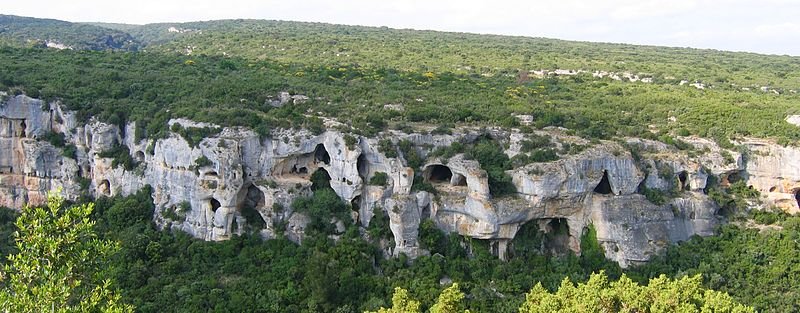75% of the Earth's land surface is covered by sedimentary rocks. Sedimentary rocks are the result of loose sediment being deposited and cemented together- commonly in bodies of water. 10% of all sedimentary rocks are limestone, which is a carbonate rock that is for the most part directly the product of biological activity. Limestone dominated landscapes are known as karsts.

A karst landscape in France. [Image source]
Karsts have a number of distinctive features thanks to their limestone composition. Limestone is somewhat soluble, causing it to erode quickly in comparison to other rocks. Acidic water exacerbates this erosion considerably. This results in truly strange looking landscapes- some of the more exotic regions of Southeast Asia, for instance, have considerable karsts. Most of the world's caves form in karst regions. Limestone also often results in extremely fertile soil.

Karst landscape in China. [Image source]
Limestone has these unusual properties due to its origins- the vast majority is made of the remains of shelled marine organisms, including corals and various shelled marine animals. They form huge limestone platforms- as the corals die and erode, they build up in huge mounds, which cement into stone. When sea levels rise, the corals grow upwards to chase the light, and the huge limestone platforms grow upwards below them. While not all limestone is biogenic (biologically originated) in nature, the vast majority of it is. 7.5% of the world's land surface doesn't sound like a lot, but it translates into a staggering amount of limestone. It's a sign of how important life has been in Earth's history that this much of its surface is essentially entirely a waste product of life.

A map of the karst terrain around the world. [Image source]
Limestone is by far the single best stone for fossil hunting, not least because considerable amounts of the karst around the world are entirely made of fossils. Limestone can only form up to a certain depth in the ocean- below that depth, the added pressure causes it to dissolve even faster.
Limestone formation varies widely throughout the Earth's history. Up until recently, we were amidst a relatively heavy period of limestone formation. Now, however, limestone formation rates are dropping precipitously. Why? Well, to put it simply, us. As we add more carbon dioxide to the atmosphere, it's damaging corals and other limestone forming organisms in two ways. First, global warming related temperature increases in the ocean are quite damaging to corals- they result in deadly coral bleaching events which have wiped out considerable amounts of the world's coral. Second, as the atmospheric CO2 percent increases, raindrops pick up more of it on their way down and react with it chemically, forming carbonic acid. All raindrops are slightly acidic, but their acidity levels have increased significantly since the industrial revolution began. This is raising the acidity levels of the oceans significantly, which in turn makes it much more difficult for marine organisms to form carbonate shells.
The extent of the harm we're doing to our planet isn't just a matter of things we're adding to our environment- it also includes ways in which we're profoundly altering the normal processes of our planet.
This is Part 3 of a series describing life's role in geological processes. Part 1, Part 2.
**********************************************************************
Bibliography:
https://en.wikipedia.org/wiki/Limestone#Degradation_by_organisms
https://en.wikipedia.org/wiki/Karst
https://en.wikipedia.org/wiki/Sedimentary_rock#Sedimentary_basins
My geology classes
